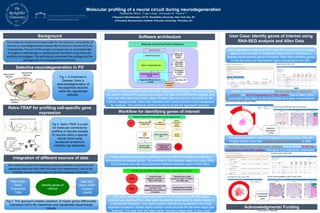
CSHL_poster_Brain_July_2016_final_version
- 1. Molecular profiling of a neural circuit during neurodegeneration Siddhartha Mitra1, Yupu Liang1 ,Alexander R. Nectow1,2 1.Research Bioinformatics CCTS, Rockefeller University, New York City, NY 2.Princeton Neuroscience Institute, Princeton University, Princeton, NJ Background Acknowledgments/ Funding CTSA award UL1TR001866 Integration of different sources of data Selective neurodegeneration in PD We created a portal that integrates publicly available connectomic and expression data sets with RNA-SEQ data from experiments. Use of the multiple sources of data helps to identify the genes of interest. Data from Retro-TRAP analysis results The molecular mechanisms responsible for the selective vulnerability of neurons in neurodegenerative disease like Parkinson’s Disease (PD) are incompletely. The aim of this project is to generate an annotated high- throughput methodology to validate genes identified using molecular profiling technologies. This will help to understand the etiology and the pathogenesis of neurodegenerative disease. Retro-TRAP for profiling cell-specific gene expression User Case: Identify genes of interest using RNA-SEQ analysis and Allen Data Allen Brain Gene Expression Data Identify genes of interest Fig 1. In Parkinson’s Disease, there is selectivedegeneration of the dopamine neurons within the nigrostriatal pathway. Fig 2. Retro-TRAP is a tool for molecular connectomic profiling of discrete subsets of neurons within a specific neural circuit using fluorescent proteins to indirectly tag ribosomes. Fig 3. This approach enables validation of master genes differentially expressed within the mesolimbic and nigrostriatal dopaminergic circuits. Software architecture Linear regression analysis is performed on the RNA-SEQ data to identify the differentially expressed genes. The workflow of this analysis needs the output RNA- SEQ pipeline and user input about the different samples used in RNA-SEQ. Workflow for identifying genes of interest Linear regression analysis of RNA-Seq data comparing the disease state vs normal state of Substantia Nigra (SNc) in Parkinson’s disease yields several genes of interest. Allen data identifies genes in this list which are themselves highly expressed in the SNc. Slc6a3 (dopamine transporter) is #314 in the linear regression analysis but #16 in expression in SNc (Allen). Use of Allen Gene expression data helps us identify Slc6a3 as a gene of importance. The gene expression sunburst diagram and the section data set images clearly show that Slc6a3 is selectively enriched in SNc. Tcf25 is ranked #20 in regression analysis, but is ranked #1883 for expression in the SNc (Allen). This gene is constitutively expressed. The genes selectively expressed relative to the background for the region involved are identified from Allen gene expression data, which is stored locally in a MongoDB database. This data is used to identify true positives in the linear regression analysis. Genes highly ranked in both sources for the brain region are selected. The data from the Allen portal, including image data, is also used. A Python / Django based web portal was created for this project. The portal allows the user to interactively upload and analyze the data from RNA-SEQ analysis, and also use Allen gene expression data. Multiple data sources are accessed by the Python / Django portal, which also interacts with Celery workers in the background for analysis. The individual workers invoke R scripts for regression analysis. Selective expression in SNc Constitutively expressed gene